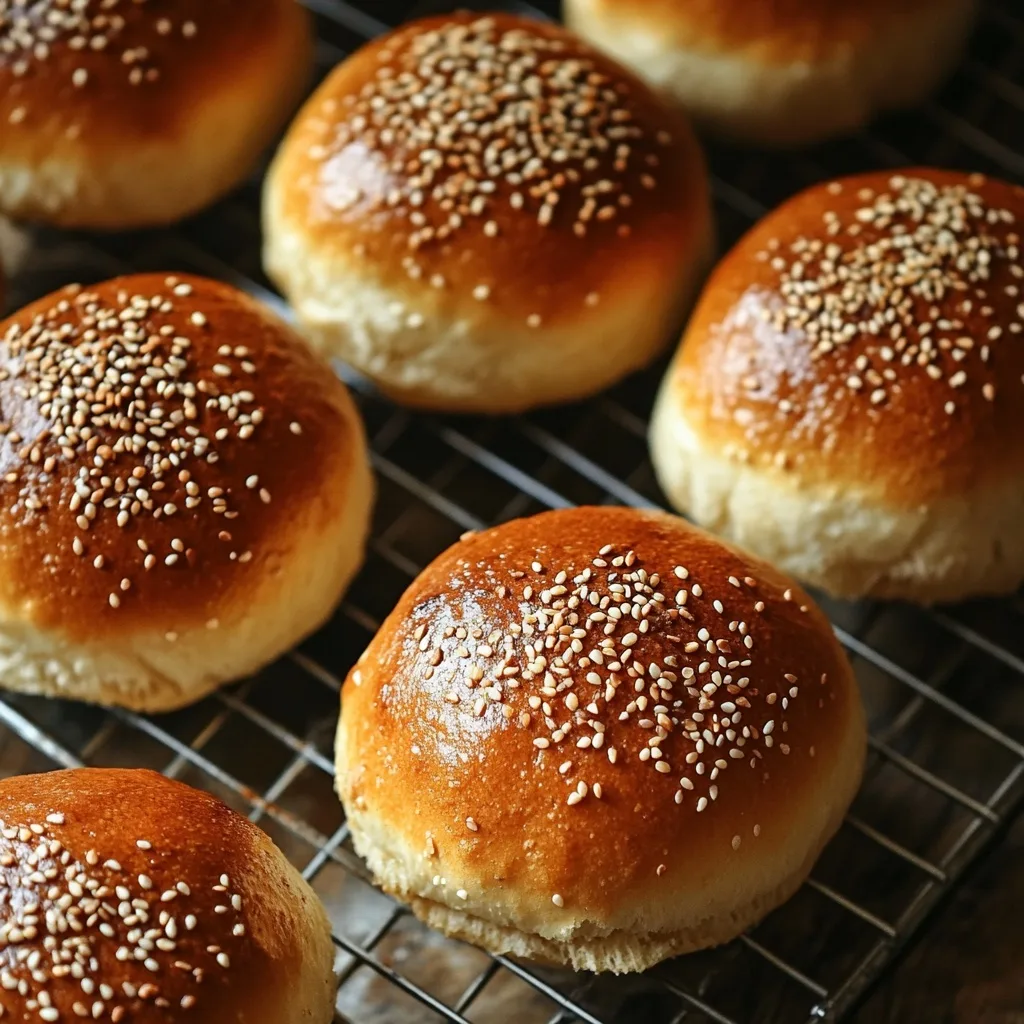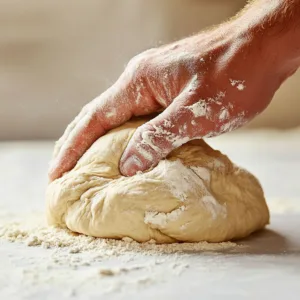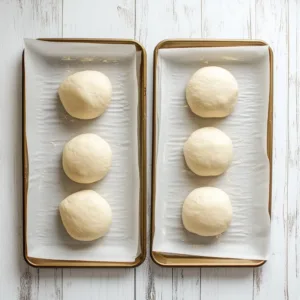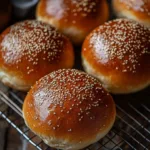I remember the first time I bit into a burger nestled in a pillow-soft bun—it was life-changing. As a mom cooking evening dinners for Emma and Chloe, I wanted every part of the meal to feel like a cozy hug.
When I discovered Tangzhong Burger Buns, it became a real kitchen love story. That gentle chew and cloud-like texture? I knew I had to share it—with my family and now with you.
Using the Tangzhong method of buns transforms humble bread into something magical. These buns aren’t just soft—they stay freshly tender long after baking.
Whether you’re planning a backyard barbecue or a Tuesday night burger, these buns bring joy from first bite to last crumb.
By cooking a small flour-and-liquid roux, the tangzhong technique creates dough that’s soft, springy, and forgiving—even on cold mornings. It also guards against dryness, keeping the texture plush (and trust me, little hands love squishing them).
Ready to fall in love with homemade burger buns? Let’s dive in. And if you’re hooked like we are, this pairs beautifully with my Gluten-Free Japanese Milk Bread (Tangzhong) and brings back the buttery warmth of Tangzhong Parker House Rolls.

Explore the Steps
Why the Tangzhong Method Makes Tangzhong Burger Buns So Incredibly Soft
What is the Tangzhong method of buns?
The magic behind Tangzhong Burger Buns starts in a small saucepan. The Tangzhong method is a Japanese technique where a portion of the flour is cooked with water and milk until it thickens into a roux-like paste. This pre-gelatinized mixture is then added to the dough, making it incredibly moist and light.
This technique is a game-changer. By hydrating the flour this way, your dough holds more moisture. That’s the secret behind Tangzhong Burger Buns that stay fluffy even the next day—something traditional buns often struggle with.
Why does it work so well? When you cook flour with liquid, it forms a starch gel that traps moisture. That gel disperses evenly through the dough, releasing steam gently during baking. The result: airy interiors, soft crusts, and a tender bite that practically melts.
How do you use this method at home?
The good news? Anyone can do it. You simply whisk together 3 tablespoons each of milk and water with 2 tablespoons of flour, then heat gently until it thickens. That’s your tangzhong. Cool it down and knead it into your dough. That one small step gives Tangzhong Burger Buns their iconic softness and signature bounce.
Want to explore more ways to use this method? Try my Tangzhong Pumpkin Bread—it’s like autumn in a loaf.
Boosting Flavor and Texture in Tangzhong Burger Buns
What is the secret of soft buns?
Softness starts with the Tangzhong, but it doesn’t stop there. For bakery-level fluff, your dough needs a little TLC. First, use enriched ingredients: whole milk or oat milk, a generous spoonful of sugar, and butter—all of which tenderize the dough and deepen the flavor.
But here’s something often overlooked: kneading. Take your time. Kneading builds gluten structure, giving your Tangzhong Burger Buns that stretchy, cohesive crumb that doesn’t fall apart mid-burger. Aim for about 10 minutes of kneading until your dough passes the “windowpane test”—when it stretches thin without tearing.
Another tip? Let the dough proof slowly and fully. Rushing the rise creates dense buns. A warm kitchen or gentle proofing oven can help. And if you want next-level softness, brush freshly baked buns with melted butter to lock in steam. Trust me, it’s like a finishing touch of love.
How to make hamburger buns taste better?
Flavor matters just as much as texture. Use quality butter—it adds richness without making the dough greasy. Whole milk brings creaminess, and the sugar (though subtle) enhances the yeast activity and rounds out the taste.
For even more flavor, use quality butter—it adds richness without making the dough greasy. Whole milk brings creaminess, and the sugar enhances the yeast activity and balances the flavor. You can also explore the nutritional impact of enriched doughs and healthier swaps on Healthline.
With just a few smart choices, your Tangzhong Burger Buns go from homemade to unforgettable.
Crispy Outside, Cloudy Inside: Perfecting Your Tangzhong Burger Buns
How to get hamburger buns crispy?
While the heart of Tangzhong Burger Buns is their soft, pillowy interior, a little crisp on the outside makes the contrast even better. To get that gentle crunch, try this: skip the butter or egg wash and brush your buns with milk instead before baking. It dries quicker and gives a more delicate crust.
After baking, cool your buns on a wire rack. This allows air to circulate, preventing steam from softening the crust. Want more crunch? Turn your oven to convection mode for the last 2–3 minutes of baking. Just don’t overdo it—these buns are meant to hug your burger, not fight it.
Another favorite trick: toast the buns lightly before serving. A quick press on a hot skillet or grill adds just enough char and texture to stand up to juicy patties or saucy fillings.
Final-proofing tips for better shape and lift
The proof is in the rise—literally. For Tangzhong Burger Buns to be tall, airy, and round, your second proof matters just as much as the first. After shaping your dough into balls, let them rest at room temp until puffy—this usually takes 45–60 minutes. They should jiggle slightly when tapped and slowly spring back when poked.
Under-proofed buns bake up tight and dense; over-proofed ones collapse or crack. So keep an eye out for that sweet spot. If your kitchen is cool, place the trays near your oven or inside with just the light on for gentle warmth.
With a soft interior and that slight outer snap, these Tangzhong Burger Buns are ready to steal the show—whether grilled, toasted, or stacked with all the fixings.

Frequently Asked Questions
What is the Tangzhong method of buns?
The Tangzhong method is a Japanese bread-making technique where a small portion of flour is cooked with liquid (usually milk and water) into a paste before being added to the dough. This step increases hydration, creating burger buns that are incredibly soft, tender, and stay fresh longer than traditional buns.
What is the secret of soft buns?
It’s all about moisture and gluten structure. Using the Tangzhong method boosts hydration, while enriched ingredients like butter, milk, and eggs make the dough tender. Kneading the dough well develops gluten, which gives the buns structure and softness. Letting the dough rise fully and not rushing the proofing process also makes a huge difference.
How to make hamburger buns taste better?
For extra flavor, use whole milk, real butter, and a touch of sugar in your dough. These enhance richness without being overly sweet. Topping the buns with sesame seeds, sea salt, or seasoning blends adds both texture and taste. Finally, brush with an egg wash before baking for a golden finish and bakery-worthy look.
How to get hamburger buns crispy?
To achieve a crispy crust, brush the buns with milk instead of egg before baking, or use convection mode for the last few minutes in the oven. Cooling the buns on a wire rack prevents steam from softening them. You can also toast them just before serving for a subtle crunch that contrasts perfectly with the soft interior.
Conclusion
Baking these Tangzhong Burger Buns is more than just making bread—it’s creating that moment when everyone takes a bite, closes their eyes, and goes “Mmm.” That soft, cloudlike interior and golden top bring a little bakery magic right into your own kitchen. Whether you’re building the ultimate burger, stacking sliders for the kids, or simply toasting one for a cozy sandwich, these buns rise to every occasion.
From my family table to yours, I hope these become a new favorite. Don’t be surprised if Emma and Chloe ask for seconds—we always do.
And if you ever have questions, tweaks, or toppings to share, my inbox is always open.
With warmth and flour-dusted hands,
Melisa 💚
Super Soft Homemade Hamburger Buns (Tangzhong Method)
Super soft, golden burger buns made with the tangzhong method. These homemade buns are fluffy, tender, and perfect for any burger night.
- Prep Time: 10 minutes + Proofing/Shaping: 2 hours
- Cook Time: 15 minutes
- Total Time: 2 hours 25 minutes
- Yield: 6 buns 1x
- Category: Bread
- Method: Baking
- Cuisine: American
- Diet: Vegetarian
Ingredients
For the Tangzhong
43 g whole milk (3 tbsp)
43 g water (3 tbsp)
14 g all-purpose flour (2 tbsp)
For the Dough
400 g all-purpose flour
50 g sugar
11 g yeast (1 tbsp)
6 g salt (1 tsp)
60 g butter
100 g whole milk or oat milk (for dairy-free)
1 large egg
For Garnish
Sesame seeds (optional)
Maldon sea salt or fleur de sel (optional)
1 large egg, for the egg wash
Instructions
Step 1. Mix the ingredients for the tangzhong in a small saucepan and whisk over low heat until it thickens to a smooth paste. Let it cool for 5 minutes.
Step 2. Melt the butter and allow it to cool slightly while you prepare the rest.
Step 3. In a large mixing bowl, combine the flour, sugar, salt, yeast, cooled tangzhong, egg, milk, and melted butter. Mix by hand or with a stand mixer fitted with a dough hook.

Step 4. Knead the dough for 10 minutes until it becomes smooth, elastic, and slightly tacky but not sticky.
Step 5. Shape the dough into a ball, place it in a floured bowl, cover with plastic wrap or a clean towel, and let it rise for 45–60 minutes or until puffed up.

Step 6. Once risen, gently press the dough down to degas and release air bubbles.
Step 7. Divide the dough into 6–8 equal portions, depending on your preferred bun size. Shape each piece into a smooth, round ball.

Step 8. Place the dough balls on parchment-lined baking sheets, leaving space between each. Cover again and let them rise another 45–60 minutes until noticeably puffy.
Step 9. Preheat your oven to 350°F (175°C) while the buns are finishing their second rise.
Step 10. In a small bowl, beat one egg. Brush the tops of the buns lightly and evenly with the egg wash. Sprinkle sesame seeds or salt if desired.
Step 11. Bake the buns for 12–15 minutes or until golden brown on top and cooked through. Internal temperature should reach 200°F.
Step 12. Transfer the buns to a wire rack and let them cool for 10 minutes before serving.
Notes
If the dough feels dry, add 1–2 tbsp of milk.
If sticky, sprinkle in a bit more flour gradually.
Nutrition
- Serving Size: 1 bun
- Calories: 423 kcal
- Sugar: 1 g
- Sodium: 388 mg
- Fat: 13 g
- Saturated Fat: 6 g
- Unsaturated Fat: 7 g
- Trans Fat: 0 g
- Carbohydrates: 63 g
- Fiber: 1.8 g
- Protein: 12.8 g
- Cholesterol: 93 mg

